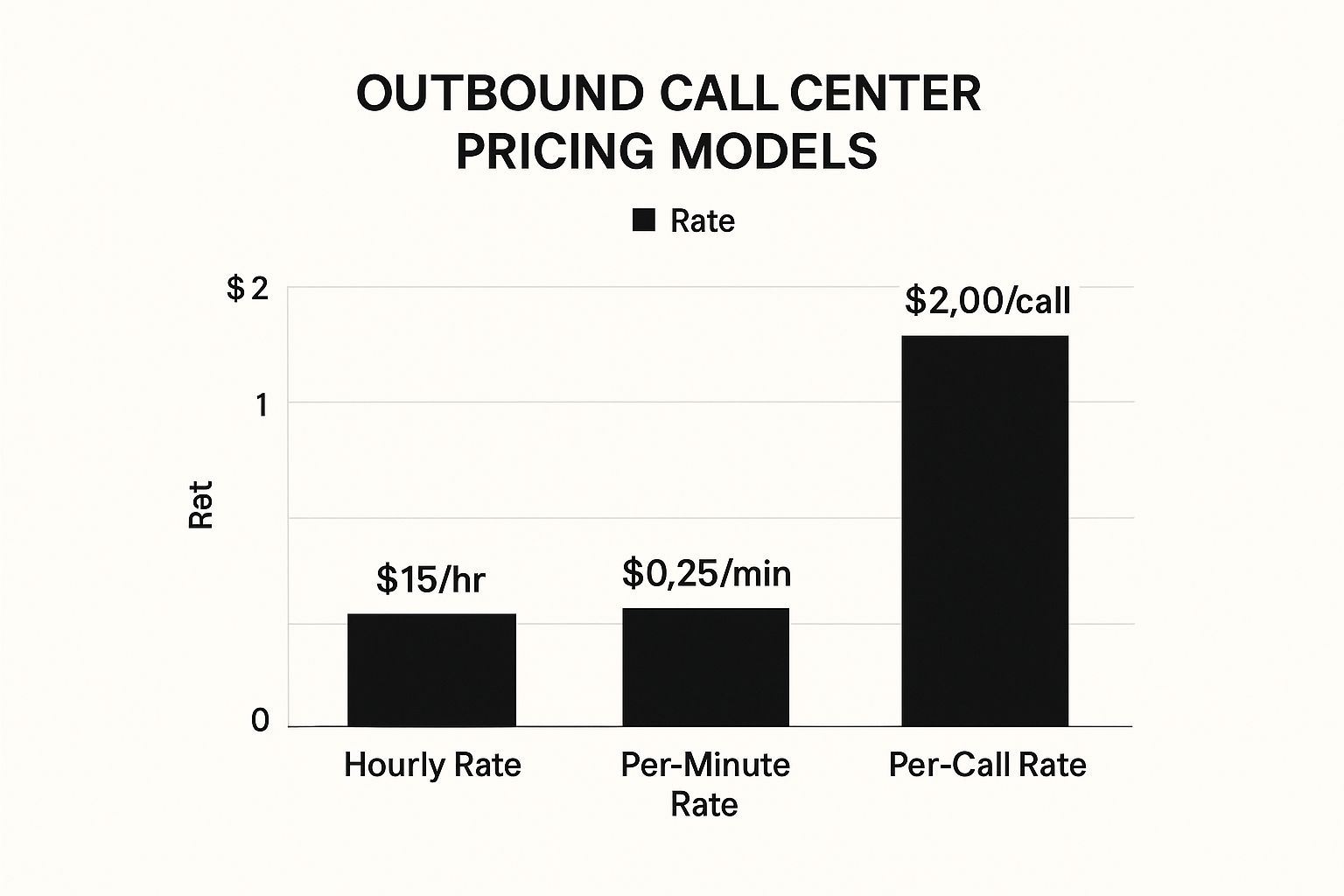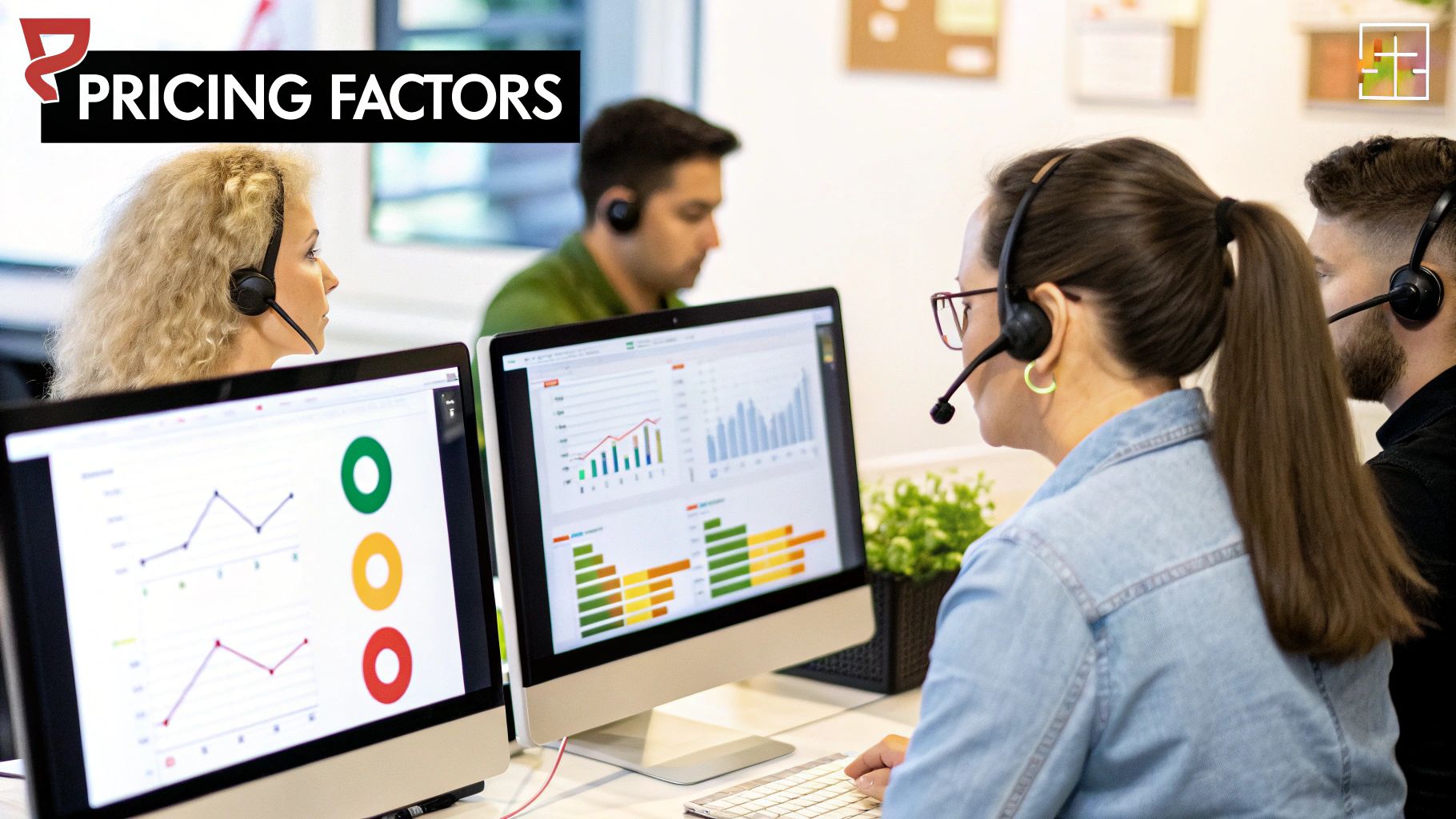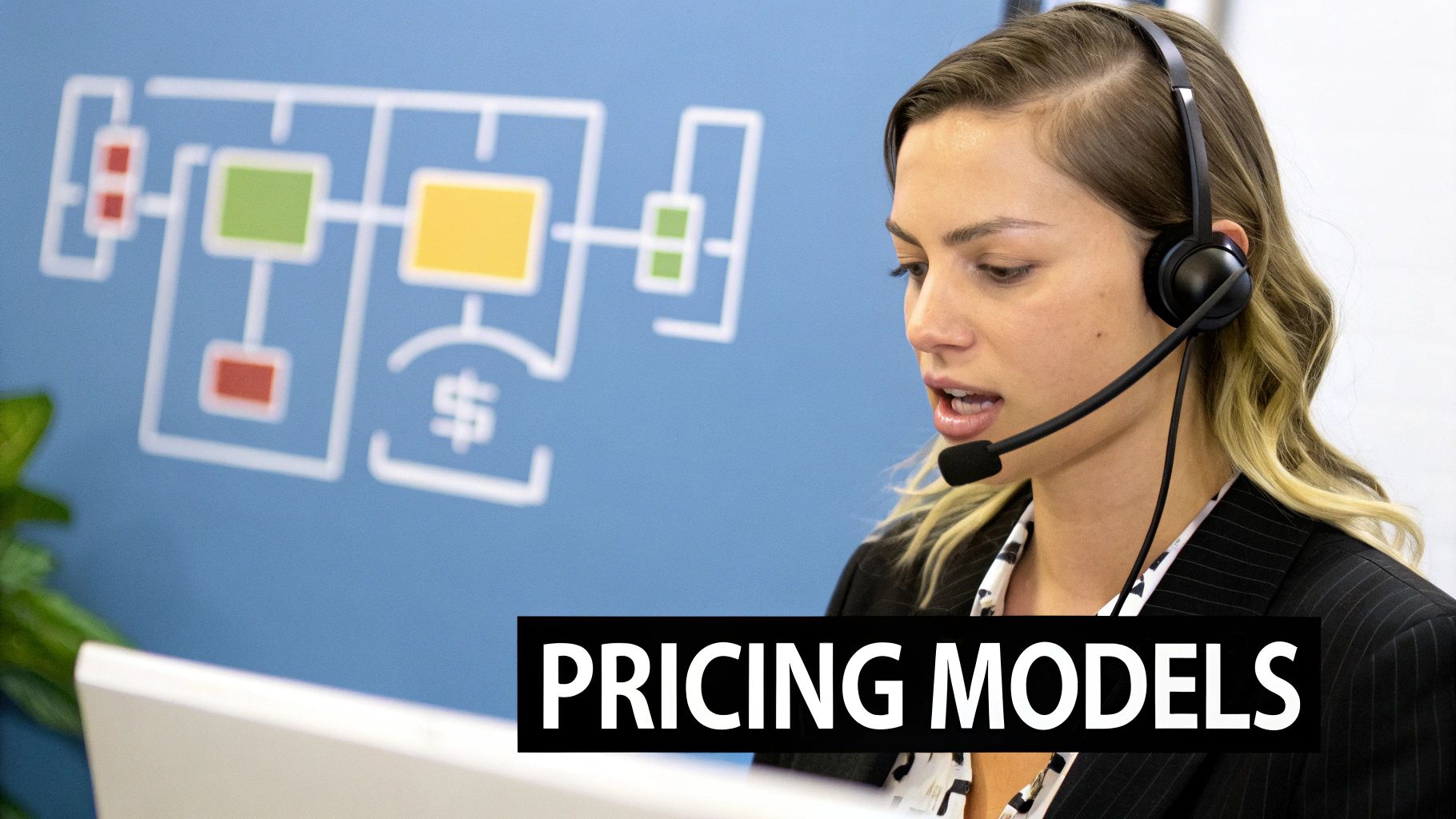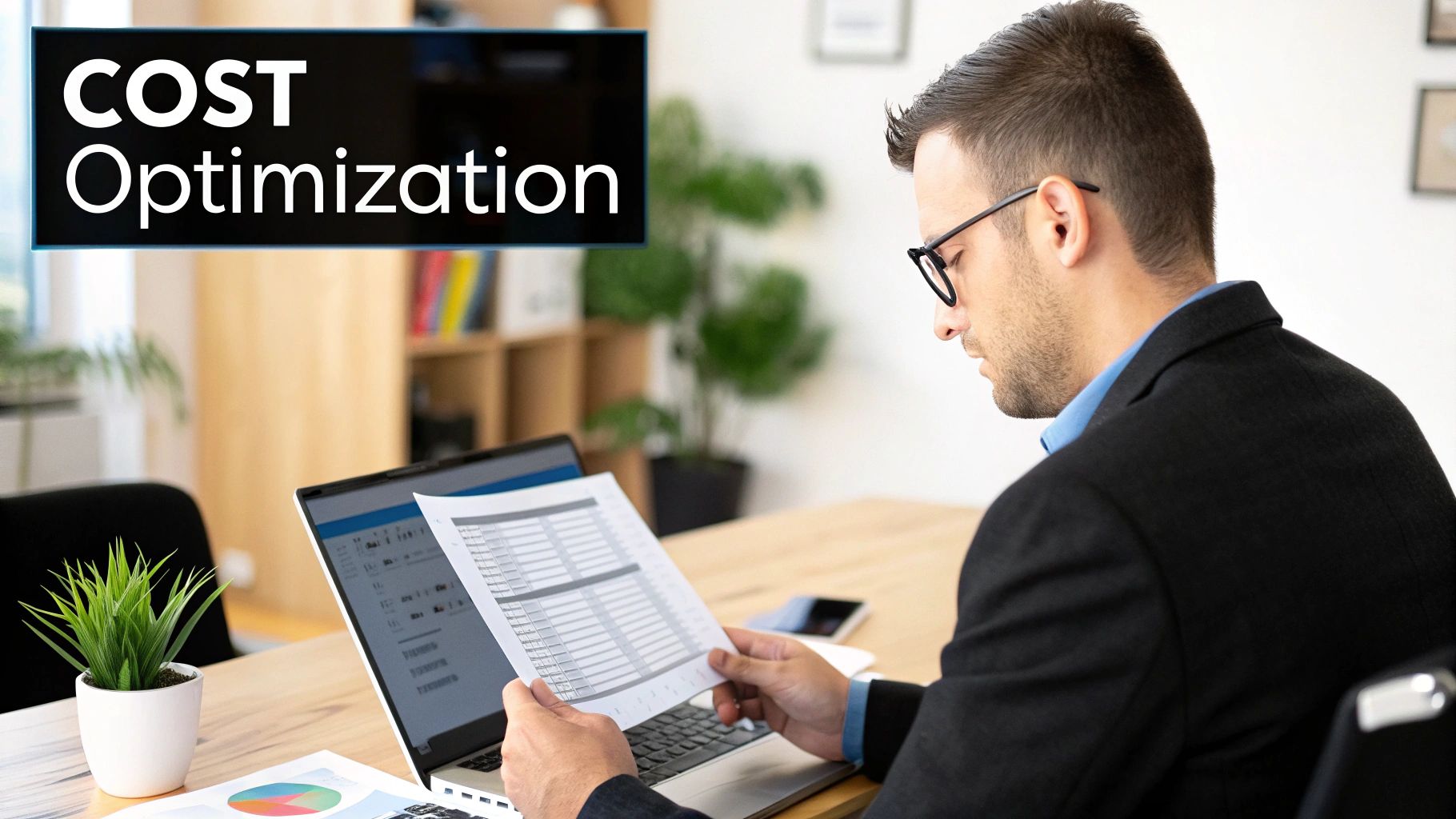Figuring out outbound call center pricing can feel a lot like trying to compare cell phone plans. Every provider seems to have a different structure, and it's easy to get lost in the details. The real key is to look past the dollar signs and understand what you're actually paying for.
Are you buying a dedicated agent's time? Or are you paying only for the exact minutes they spend talking to prospects? Maybe you only want to pay for solid results, like a booked appointment or a qualified lead. Each model fits a different business goal.
Choosing the right pricing model really comes down to your campaign's goals, how predictable your outcomes are, and how much risk you're willing to take on.
For example, if you're running a straightforward market research survey with a clear script, a stable hourly rate makes a lot of sense. You know what you're getting and what it'll cost. But for a high-stakes sales campaign, you might lean towards a performance-based model where you only pay when the call center delivers a tangible result.
The pricing structure you choose sets the tone for the entire financial relationship with your call center partner. Here are the three main flavors you'll come across:
This infographic breaks down what you can generally expect to see for rates across these different models.

As you can see, the cost-per-unit varies wildly. That’s why having a good handle on your expected call volume and conversion rates is so critical for forecasting your total spend.
To make it even clearer, here’s a quick comparison of the primary pricing models to help you see which one might be the best fit for your campaign.
Ultimately, the best model is the one that aligns with your budget, risk tolerance, and campaign objectives.
Since so many outbound campaigns are built around prospecting, getting a solid grasp on how to outsource lead generation can really help you decide which pricing structure delivers the best value for your goals.
Despite all the talk about digital channels, outbound calling is still a massive growth engine. In fact, companies that use cold calling see 42% more growth than those that don't. It's a testament to its enduring power when done right.

When you're choosing an outbound call center, it's tempting to just hunt for the cheapest option. But that's a mistake. The real win comes from picking a pricing structure that actually makes sense for your campaign's goals. Get it right, and it feels like a genuine partnership. Get it wrong, and you're looking at misaligned incentives and a budget that vanishes with little to show for it.
Every model shifts the risk and reward differently. Think about it: a B2B tech firm trying to book high-stakes demos with executives would get the most bang for their buck with a performance-based model. On the flip side, a massive market research project with a simple, predictable script would probably find a stable hourly rate offers the best value.
Let's break down the most common outbound call center pricing models to figure out which one fits your business like a glove.
This is the classic, most straightforward approach you'll find. You pay a set rate for every hour an agent is working on your campaign, simple as that. It doesn't matter what the call outcomes are; you're paying for their time and effort. This model gives you incredibly predictable billing, making it perfect for campaigns where consistent activity is the name of the game.
If you want to get more granular, the pay-per-minute model might be for you. With this structure, you're only billed for the time agents are actively on the phone with prospects. It naturally encourages efficiency since you aren't paying for the downtime between calls. For international centers, you'll often see rates between $0.27 to $0.45 per minute.
This model is a great match for high-volume campaigns where calls are short and sweet. But be warned—it can get expensive fast if your calls end up being longer or more complex than you planned. You really need to have a solid handle on your average call time to make this work.
For campaigns focused on immediate results, a shift in mindset is required. Instead of paying for effort, you're investing directly in outcomes. This is where performance-based models truly shine, aligning the call center's success directly with your own.
This is the ultimate results-driven structure. With a pay-per-performance model, you only open your wallet for specific, pre-defined outcomes—like a qualified lead, a booked appointment, or a closed sale. This model completely flips the script, shifting all the performance risk from you to the call center.
Sure, the cost per result is higher, but it guarantees your budget is only spent on things that add real value to your bottom line. It's the perfect setup for sales-focused campaigns where the ROI for each conversion is crystal clear. This model builds a powerful partnership, as the call center is intensely motivated to perfect their scripts, train their agents, and optimize call lists to boost their earnings—which, in turn, boosts yours.

You won't find a simple price list for outbound call center rates, and for good reason. The final quote you receive is a blend of several key variables, each playing a big part in your total investment.
Think of it like commissioning a custom piece of furniture. The type of wood, the complexity of the design, and the artisan's skill level all come together to determine the final price.
Similarly, outbound call center rates are shaped by the specific demands of your campaign. Getting a handle on these cost drivers is the first step toward negotiating a fair price that lines up with your quality expectations and budget.
One of the biggest factors right off the bat is agent location. An onshore agent based in the US or UK will naturally command a higher rate than a nearshore or offshore agent. This comes down to simple economics—differences in labor costs and the cost of living.
But it’s not just about geography. Agent skill is just as critical, if not more so.
The more specialized the agent's skill set, the higher the cost. You're not just paying for their time but for their expertise, industry knowledge, and ability to represent your brand effectively.
The technology stack is another major piece of the cost puzzle. A modern call center isn't just a room full of phones; it relies on sophisticated dialing software, CRM systems, and analytics platforms to maximize every minute. These tools come with licensing fees that get factored into your rate.
On top of that, the industry is constantly adapting to new compliance rules and the challenge of call blocking. Modern outbound strategies now require an omnichannel approach, mixing calls with SMS and email to keep contact rates high.
Ultimately, a clear understanding of these variables helps you look beyond the price tag. It allows you to evaluate how your campaign costs fit into the bigger picture of your overall Customer Acquisition Cost (CAC).
To make this clearer, let's break down how these different factors can push your rates up or down.
As you can see, a lot goes into that final number. The key is to find a partner whose costs align with the value and results you're looking for.
When you start budgeting for outbound services, the first thing you'll notice is that one factor overshadows all others: agent location. The outbound call center rates you see are almost entirely driven by geography. This isn't surprising—it reflects massive differences in labor costs, local economies, and infrastructure from one country to another.
Think about it like hiring any professional. You wouldn't expect to pay a developer in San Francisco the same rate as one in Southeast Asia. Call centers work the same way. Getting a handle on these regional benchmarks is the first step to evaluating proposals and knowing a good deal when you see one.
The demand for these varied service locations has pushed the global call center outsourcing market to a projected $27.64 billion. It’s a clear sign that businesses are getting strategic, weighing cost against quality. If you want a deeper dive, industry reports on the top outbound call centers are a great place to start.
So, what should you actually expect to pay per hour for a dedicated agent? Here's a realistic breakdown based on where they're located:
Onshore (USA/Canada): $20 – $30 per hour. You're paying a premium here, but for good reason. Onshore agents live in the same cultural context as your customers. They get the slang, the local references, and the subtle conversational cues. This is a huge advantage for complex B2B sales or high-stakes campaigns.
Nearshore (Latin America): $8 – $18 per hour. This is the sweet spot for many businesses. You get significant cost savings without sacrificing too much in cultural alignment. Nearshore agents typically have excellent English skills and work in similar time zones, which makes day-to-day collaboration a breeze.
Offshore (Philippines/India): $6 – $14 per hour. If budget is your top priority, this is where you'll find the most aggressive pricing. Offshore locations offer incredible value. The Philippines, in particular, is famous for its massive, English-proficient talent pool and a culture that's deeply rooted in customer service.
Don’t just chase the lowest number. Choosing a location is a strategic move. You have to balance the price tag with what your campaign truly needs—be it cultural affinity, language mastery, or time zone convenience. Getting this right is what separates a successful campaign from a frustrating one.

Knowing the different outbound call center rates is one thing, but actually picking the right one for your campaign? That's a whole different ball game. The decision really boils down to your primary goal, how flexible your budget is, and the amount of risk you're willing to take on.
What works wonders for one company could easily be a financial disaster for another.
For example, if you're a startup with a shoestring budget trying to test the waters in a new market, a performance-based model is your best bet. This approach ties your costs directly to results—like qualified leads or appointments—which minimizes your upfront financial exposure. You only pay when you see tangible progress.
On the other hand, an established brand running a big customer feedback survey needs predictability. For them, an hourly or flat-fee rate makes more sense. It provides clear budget stability, which is perfect when the goal is consistent activity, not necessarily instant conversions.
To land on the most strategic and cost-effective choice, you have to ask yourself the right questions. Your answers will steer you toward the pricing structure that truly fits what you're trying to accomplish.
The right pricing model isn't about finding the cheapest option; it's about creating a true partnership. Your choice should incentivize the call center to achieve the exact outcomes that drive your business forward, creating a win-win scenario.
When you start digging into proposals for outbound call center services, a lot of questions pop up. Getting straight answers is the only way to make a smart decision and avoid nasty surprises on your invoices later on. Let’s clear the air on some of the most common things business owners ask.
The hourly or per-minute rate you see on a proposal is almost always just the starting point. It's the "fine print" where the real costs can pile up, so you have to be your own best advocate and know what to look for.
Keep an eye out for these common add-ons that don't always make it into the headline price:
Always insist on a complete, itemized cost breakdown before signing anything. It’s the easiest way to prevent unexpected charges.
Campaign complexity is one of the biggest factors driving your final rate. Think about it: a simple, scripted call to conduct a survey is worlds away from a complex B2B sales call that demands deep product knowledge and a consultative approach.
The more skill and expertise an agent needs to bring to the table, the higher the rate is going to be.
It's a lot like hiring a contractor for your house. You'd pay a general laborer a certain rate for a simple job, but you'd expect to pay a master craftsman significantly more for a detailed, custom project. The exact same idea applies to agent skill levels in a call center.
While the cost savings from offshore outbound call center rates can look incredibly tempting, they aren't automatically the right move for every business. You have to carefully weigh the lower price tag against potential trade-offs that could impact your brand's reputation and your campaign's results.
Be sure to consider things like major time zone differences, subtle cultural nuances in conversation, and language accents. For some campaigns, these are non-issues. For others, they can be serious roadblocks that tank performance.
Ultimately, the cheapest option is only "better" if it actually delivers the results you need.
Ready to skip the complexity and high costs of traditional call centers altogether? My AI Front Desk offers an AI-powered outbound dialer that runs campaigns with incredible precision and efficiency, turning more of your leads into revenue.
See how our AI solutions can completely reshape your small business outreach at https://myaifrontdesk.com.
Start your free trial for My AI Front Desk today, it takes minutes to setup!








